Yesterday’s upbeat employment data left many readers questioning the veracity of the alternative Roy Morgan Research employment survey, which registered a very large jump in unemployment in January (see here and here).
While it is true that the results for January were contradictory, I believe it is too early to discount the Roy Morgan numbers, and readers should wait a few months before forming any conclusions.
Professor Steve Keen wrote an excellent article last week comparing the two measures:
According to the ABS definition, a person who has worked for one hour or more for payment or someone who has worked without pay in a family business, is considered employed regardless of whether they consider themselves employed or not.
The ABS definition also details that if a respondent is not actively looking for work (ie: applying for work, answering job advertisements, being registered with Centre-link or tendering for work), they are not considered to be unemployed.
The Roy Morgan survey, in contrast, defines any respondent who is not employed full or part-time and who is looking for paid employment as being unemployed.
Since Roy Morgan uses a broader definition of unemployment than the ABS, it neccessarily reports a higher unemployment figure. In addition, Roy Morgan’s measure tends to be far more volatile, owing to the fact that it draws on a smaller sample than the ABS and is not seasonally adjusted.
The issue of seasonal adjustment is particularly important in the context of January’s employment figures. January is a month where a large number of school leavers hit the job market, which typically causes the number of unemployed and the unemployment rate to spike. And since Roy Morgan’s figures are not seasonally adjusted, part of the increase in the unemployment rate in January relates to the school-leaver effect, as noted by Gary Morgan:
“Unemployment traditionally rises in January — the Roy Morgan unemployment estimates tables below show unemployment numbers have risen in 9/11 years since the turn of the century. The rise is because young people emerging from school are waiting for University offers — especially second round offers, and other young people are yet to decide whether to continue further University study and seek employment while they consider their options.
“Recent University graduates looking for work are also uncertain about the year ahead as post-graduate job offers are yet to be made and many people who may be offered a job in February are themselves job-hunting in January just in case the post-graduate job offer doesn’t materialise. The Roy Morgan unemployment estimates show that unemployment consistently drops in February (7/11 years) as students receive formal job offers and transition into full-time work.
The school-leaver effect is also evident in the non-seasonally adjusted (NSA) figures from the ABS, which showed an increase in the unemployment rate to 5.5% from 5.0%, compared with a 0.1% fall in the seasonally adjusted (SA) figure:
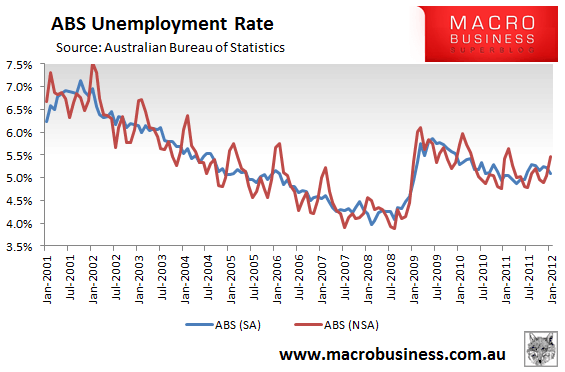
Nevertheless, when the NSA ABS unemployment rate is compared against the Roy Morgan number, the divergence is striking:
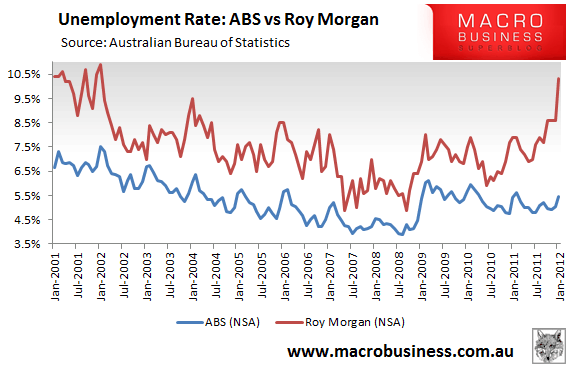
Given the inherent volatility in monthly series, I often like to smooth the data by applying a 3-month moving average (3MMA). The result is shown below for both the ABS and Roy Morgan series:
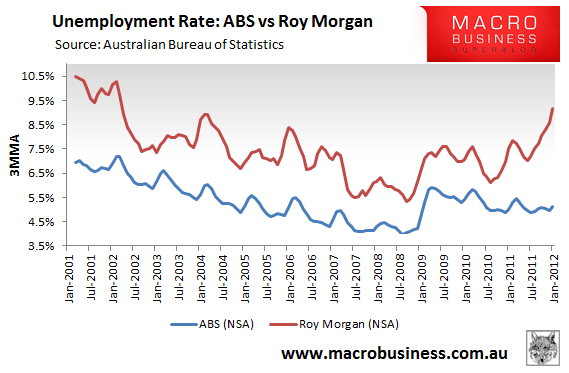
As you can see, the two series are highly correlated. But something weird happened in January, with both series diverging by 5.2% – the greatest margin in 11-years and well-above the average divergence of 2.2%:
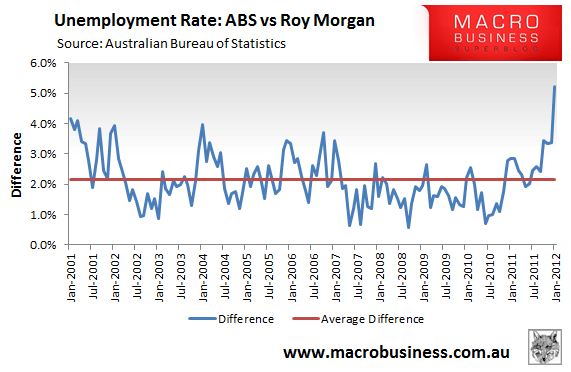
Which measure is right or wrong with respect to the direction of the labour market remains to be seen. Either Roy Morgan’s unemployment rate will retrace sharply in coming months (beyond usual seasonal movements), the ABS figure will deteriorate toward Roy Morgan’s, or some combination of the two.
Turning back to yesterday’s ABS employment analysis for a moment, one of MacroBusiness’ many insightful readers, Magpie, pointed to an important quote from the ABS regarding the sharp fall in aggregate number of hours worked, which was the largest fall since February 2009 (see below charts) and basically took us back to the previous January:
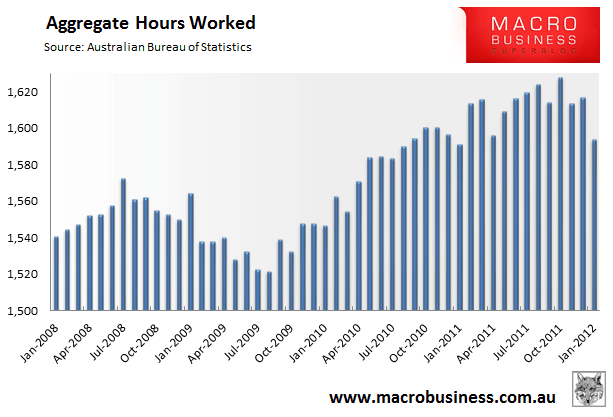
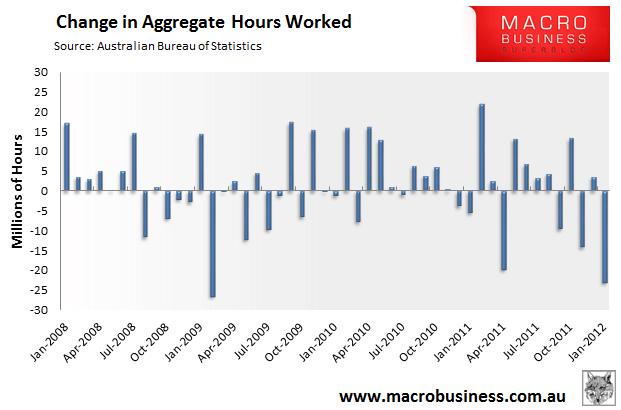
Aggregate monthly hours worked… can sometimes be more revealing of what is happening in the labour market, particularly in a weakening economy where a fall in hours worked can usually be seen before any fall in the number of people employed.
As I said yesterday, the fall in the aggregate number of hours worked was the only blemish on an otherwise strong set of numbers. And it also fits with the explanation that the Roy Morgan method will pick up a loosening in the labour market more quickly than the ABS method owing to its greater sensitivity to limited hours.
The media response to yesterday’s figures was rightly quite circumspect. It’s only one month’s data in what can be a volatile series. Given the uncertainty around the sharp divergence between the Roy Morgan measure and the official ABS measure, as well as the spate of announcements of job cuts, I’ll wait for a few more months of data before forming any strong opinions either way regarding the direction of the labour market.

